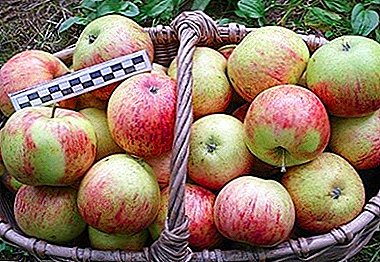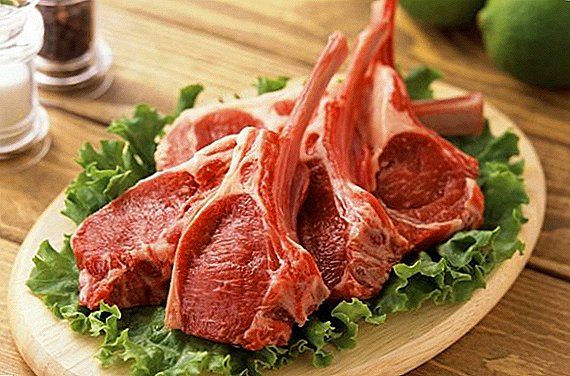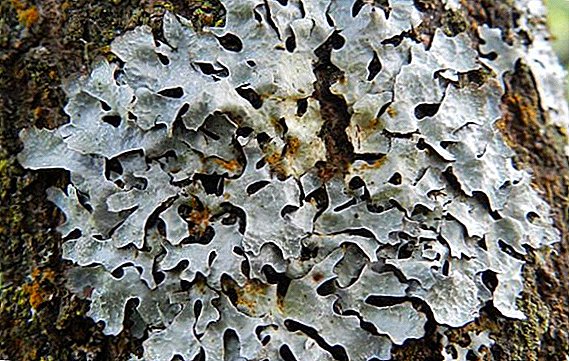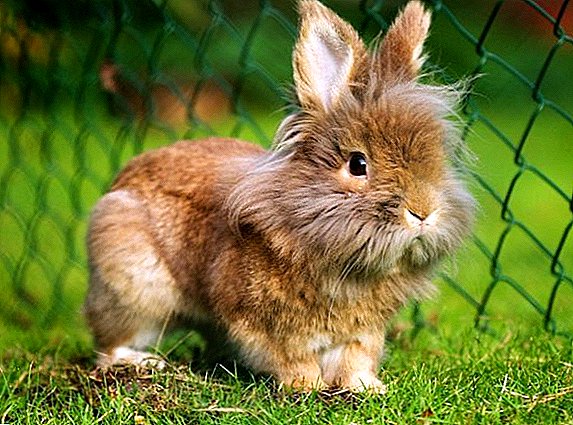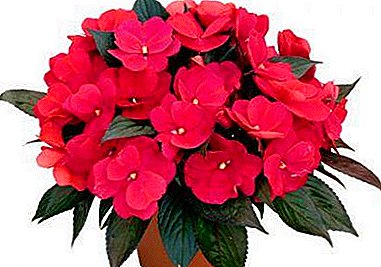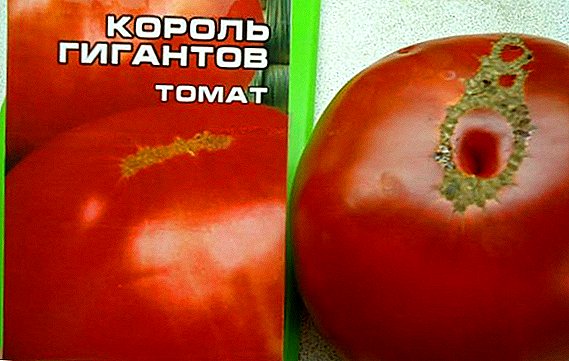 Tomatoes are a popular vegetable on our table all year round. We owe their appearance in our diet to Christopher Columbus, who brought culture to European lands from Central America in the XYI century. Two centuries later, a tomato came to Russia. Here they were grown as a decorative crop, as the fruits did not have time to ripen due to low temperatures. Today, breeders have made sure that the crop can be grown in almost any climate. In this article we will talk about the popular, albeit relatively new variety of tomatoes, "The King of Giants."
Tomatoes are a popular vegetable on our table all year round. We owe their appearance in our diet to Christopher Columbus, who brought culture to European lands from Central America in the XYI century. Two centuries later, a tomato came to Russia. Here they were grown as a decorative crop, as the fruits did not have time to ripen due to low temperatures. Today, breeders have made sure that the crop can be grown in almost any climate. In this article we will talk about the popular, albeit relatively new variety of tomatoes, "The King of Giants."
Variety description
The plant is truly gigantic in size. Grown in the greenhouse bush can reach 180-200 centimeters. On open ground, the growth is not as significant. Here, the height of the bush reaches 150-160 centimeters. Unfortunately, for such sizes, the stem of a tomato is quite fragile. Under the weight of huge fruits can easily break off. 
Stem densely littered with tassels. They are located on it through three or four sheets. The ovary is formed on the hand after the appearance of the ninth permanent leaflet.
The advantages of the variety:
- high yields;
- resistant to late blight;
- large fruits of excellent presentation;
- great taste;
- fruits are universal in use;
- excellent transportability and keeping quality of fruits.
Disadvantages:
- whimsical seedlings (requires pre-preparation before planting and good care after);
- fruits must be harvested unripe, as overripe lose their presentation;
- does not like abundant watering.

A distinctive feature of this variety in front of others is resistance to diseases and pests.
Did you know? When tomatoes appeared in Europe in the XYI century, they were long considered unsuitable for consumption and even poisonous. They are often thrown at foes as poison.
Fruit characteristics and yield
The fruits of the "King of the Giants" are bright red, round, slightly flattened along the vertical axis of the form. The weight of one tomato on average varies between 500 and 1000 g. There are even larger specimens. Their flesh is dense, fleshy.
It is divided into 6-8 cameras. The taste is rich, sweetish, with light notes of sourness. If the tomato is overripe, the pulp acquires a sugary taste.
About 5.5-8 kg of tomatoes can be removed from one bush.  Harvest can be 115 days after planting seedlings in open ground, so the variety is considered early ripening.
Harvest can be 115 days after planting seedlings in open ground, so the variety is considered early ripening.
To early ripe varieties of tomatoes include such as "Samara", "Explosion", "Kiss of geranium", "Bokele", "Caspar", "Batyan", "Irina", "Labrador".
Selection of seedlings
The rules for choosing seedlings are similar for all varieties of tomatoes.
- Saplings should not be more than 45-60 days. They should be chosen all at about the same age, so that the growth and ripening of the fruit were uniform.
- The height of the seedlings should be up to 30 centimeters. In addition, since the “King of the Giants” is a tall plant, there should be 11–12 leaves on its stem.
- The stem of the sapling should be as thick as a pencil. Its color, like the color of foliage, must be saturated green.
- The root system should be well developed, with no visible defects.
- It should be checked for the presence of pests and infections in the seedling. Eggs pests are laid under the foliage, and if there is a disease, it alters the leaves. On the stem should not be brown or black spots.
- Leaves can be too green and curled. This indicates improper growing seedlings. These changes indicate a soil oversaturation with nitrogen.
- The seedlings put up for sale should be in boxes with earth and fresh in appearance.

Important! If, when choosing a seedling on at least one seedling, there were signs of illness or a pest, do not buy it.
Soil and fertilizer
In the area chosen for gardening, the soil should be moderately saturated with fertilizers, with medium acidity, moderately wet, well heated and ventilated. Tomatoes can be planted in the beds, where cucumbers, zucchini, pumpkins, squash, turnips, cabbage, green onions, carrots, beetroot and green manure have grown.
Among these cultures, the best predecessors are any cabbage and pumpkin. It is not recommended to plant tomatoes after tomatoes, potatoes, peppers, eggplants, Physalis, peas.
Soil preparation is as follows:
- cleaning beds from weeds and seeds of other crops;
- soil testing for pests;
- make it so that the earth can hold moisture;
- soil acidity lead to an average;
- make biohumus, ash, sand.

You can pour a special soil mixture, sold in stores, on your chosen bed, or you can make it yourself. For this you need peat, turf in a ratio of 3: 1, sawdust, mullein and peat in a ratio of 1: 3.
All this is mixed with sand and peat, taken in the same amount, as well as with soil, manure and ash.
For feeding tomatoes, it is recommended to use superphosphate, nitroammofosku. Acceptable use of organic fertilizers, diluted with water, and infusion of nettle. Make a feeding should be according to a previously developed scheme.
It may be something like this: once every 10 days. For the first time, fertilizers should be applied 14 days after planting the seedlings. 
Growing conditions
In open ground, seedlings are planted when frosts stop. For their normal development requires an air temperature of 22-25 degrees and a lot of light. If the temperature drops to 10 degrees, the pollen will not ripen, and without fertilization, the ovary will crumble.
And when there is insufficient light, the growth of the seedling slows down, the stem stretches out and changes in color, becomes pale. Does not like tomato high humidity. When it begins to actively develop many diseases.
Growing from seed to seedlings at home
Seedling "King of Giants" is better to grow independently. So you will be confident in the quality of seedlings. To get good seedlings, read the information below.
Seed preparation
Seeds for planting preferably purchased from trusted suppliers. 
Then there will be a guarantee that they correspond to this variety and are treated for diseases and pests. If you are harvesting planting material yourself or purchased it from unknown vendors, then the seeds should be treated with a solution of potassium permanganate.
Then rinse under running water. After placing for a day in a solution to stimulate growth.
Content and location
For seedlings use boxes. They are filled with a special soil mixture and planted seeds. Top boxes covered with glass or film to create a greenhouse effect. The seedling is placed in a warm place with a temperature not lower than 18 degrees.
Seed planting process
Sowing seed for seedlings is carried out at the end of February at the beginning of March. First, the soil is prepared: two parts of the ground are mixed from the garden with one part of the river sand. This mixture must be calcined, and then mixed with the ash, ground into a powder. 
When the soil is scattered in boxes, you can begin to process the seed with potassium permanganate. Finished seeds spread in the groove depth of the order of a centimeter and a centimeter distance from each other. Slightly recessed into the soil seeds are sprayed from a spray bottle.
The boxes are covered with film or glass and placed in heat until germination. When the shoots will appear on three leaves, they need to dive. Seedlings are planted in separate pots. In the third or fourth decade of May, seedlings can be transplanted into a greenhouse at a permanent place.
Seedling care
Shoots should receive enough light. If the light day is not too large, then you should resort to the illumination. Watering should be timely and moderate. When the seedlings are ready for transplanting into open ground, they need to undergo a course of tempering procedures. 
They consist of the following: one and a half weeks before transplantation, seedlings must be taken out to fresh air. For the first session, 30 minutes will be enough, then an hour and a half and eventually five hours.
Two days before the completion of the procedures, the boxes with the seedlings can be left in the greenhouse for 7-8 hours, but taking into account the fact that by this point the frosts have already disappeared.
Transplanting seedlings to ground
Planting seedlings in the soil is carried out after the end of frosts. At least one bush should be planted on one square meter of bed, ideally two. Bush should have one or two stems. To do this, you must delete the stepsons.
When the seedling is transplanted into the open ground, a bush is dug out together with the ground and placed in a prepared hole. Sprinkled on top of the ground. A planted crop requires regular watering until it takes root in a new place. 
Agricultural technology of growing tomato seeds in the open ground
The technique of growing tomatoes from seeds in the open field is very similar to the seedling method, but still has its own characteristics.
Outdoor conditions
Tomatoes are heat-loving crops, so they can only be grown in open fields in the southern regions. In temperate latitudes, it is necessary to sow seeds for seedlings in boxes or greenhouses, since the warm period is not long, and the fruits will not have time to ripen.
But even if in the southern regions it is possible to plant seeds in the open ground, the beds still need to be covered with a film to create a certain microclimate. Choosing a place under the greenhouse is similar to choosing a place for planting seedlings.
The process of planting seeds in the ground
In a prepared greenhouse or greenhouse, seeds are sown 55-65 days before transplantation into open ground. 
Approximately this is the end of March - the beginning of April. Planting material is treated with a solution of potassium permanganate. One square meter of area should be spent 9-10 g of seeds.
Holes and rows should be placed at a distance of 3-4 cm from each other. Sow the seed at a temperature of + 23 ... +25 degrees. When the first shoots appear, the temperature in the heated greenhouse is reduced by 4-7 days to + 12 ... +15 degrees during the daytime and + 6 ... +10 degrees at night.
A sharp drop in temperature is necessary in order for the seed to stop living at the expense of its resources and start getting all the necessary things from the soil. With the advent of the first true leaflets, the temperature is again raised to + 20 ... +26 degrees.
Important! From time to time, the greenhouse must be aired so that the seed does not become damp and moldy.
Watering
For irrigation, it is necessary to build an irrigation system.  It should contain room temperature water (+20 ° C). In this way, watering tomatoes is enough once or twice a week. It is advisable to carry out the procedure before sunset, especially if the tomatoes grow in the open field, and the soil has not had time to warm up enough after the winter.
It should contain room temperature water (+20 ° C). In this way, watering tomatoes is enough once or twice a week. It is advisable to carry out the procedure before sunset, especially if the tomatoes grow in the open field, and the soil has not had time to warm up enough after the winter.
From the watering can, the plant is watered only in case of severe droughts, and then twice a summer. In the rainy season you can do without irrigation.
If the tomatoes are already planted in a permanent place, then when the formation of the ovaries and fruit ripening begins, the frequency of watering should be increased to two or three times a week.
Soil loosening and weeding
The soil must be loosened after irrigation. While the seedlings are still young, it is enough to fluff the upper layer a little so as not to form a crust. When the bushes grow up and get stronger, during loosening you can go deeper into the ground by 4-5 cm. Together with the loosening of the soil weeds are also removed. 
When tomatoes are transplanted to a permanent place, the first loosening of the soil and weeding is carried out 10 days after the transplantation. For the first time, they dive 8-12 cm into the soil, the subsequent times - by 4-5 cm. If heavy rains have passed, then after them it is also necessary to loosen the soil.
So that the moisture evaporated less and the weeds did not grow, it is advisable to mulch the beds.
Masking
Since the "King of the Giants" is a tall enough plant, it is necessary to closely monitor the formation of the bush and from time to time to carry out its adjustment. It consists in pinching. The first stepson (escape between the main stem and the leaflet) appears along with the first floral brush.
Learn how to properly pinch tomatoes in the open field and in the greenhouse.
He is the strongest and can be left. All others appearing below it are subject to removal. They can be torn off by hands or cut off. If you plan to tear off, then you need to work in gloves. They break off easily when tilted to the side. 
If you work with garden shears, then after each pruning, it is necessary to disinfect the instrument with potassium permanganate, so as not to spread the infection. The frequency of the procedure - once a week.
If it is not possible to trim the shoots so often, then the first time they are removed in the middle of summer and the second time - one month before the last harvest.
It is necessary to form a bush so that it is not spreadingotherwise it will be difficult for him to bear the weight of large fruits. To achieve compactness of the bush can only be leaving one or two stems. If the bush is poorly formed, then it is necessary to remove extra flowers.
When the first brushes begin to appear, it is necessary to prune the foliage to the ground. 
Garter
The benefits of garter tomatoes:
- the plant is easier to hold heavy fruit;
- when the bush is vertical, the sun's rays evenly fall on it. Also in this position, the bush is well ventilated;
- when the fruits do not touch the ground, they are not so afraid of heavy rains and mice, slugs will not spoil them;
- tied up plant is easier to water, process from diseases and pests, care for the soil around it.
There are many ways to garter.
Learn how to tie up tomatoes in the greenhouse and in the open field.
We describe some of the most popular:
- using pegs. This method is mainly used for culture growing in the open field. The peg can be metal or wooden, at your discretion. In height should be about 200-250 cm, depending on the height of the bush. The support is driven into the ground at a distance of 10 cm from the bush in order to injure the root system less. The plant is tied to a peg freely. The string or fabric strip is wrapped first around the support, and then around the stem and ovary. When the bush grows up, it is necessary to tie it in addition;

- on the trellis. This method is beneficial if you have a large crop plantation. To build a support, you need to take a bar or pegs. They are driven in at the beginning and end of the row and tensioned with wire. It can be stretched alone, at a height of 200 cm, and a bush tied to it, or several wires, and a bush will be stretched through them. Wrap a rope or string around the plant neatly;

Important! If the bed is too long, then you need a little more pegs on it.
- wire frame. It is made in the form of a cylinder or a prism of wood or metal. It is easier to make a cylindrical frame out of metal. The wire is bent in a circle. There should be several such circles. On one circle, weld the bars at an equal distance from each other. Frequency does not matter. Then, at the same distance, the remaining rings are welded onto the bars. A frame prism is made of wood. The method is similar with the only difference that the base is not a circle, but a square, and instead of welding nails are needed;

- wire fence. Along the rows of tomatoes stretch two-meter wire nets. To them and tied bushes with twine. The advantage of this design is that as the bush grows, it can be untied from one level and tied to another.

For the "King of Giants," any of the above-described garter methods will work. Choose at your discretion.
Top dressing
In the open ground, the first top dressing of the strengthened seedling is carried out two months after the emergence of seedlings. Under the shrub make a mixture of 0.5 liters of mullein, two microfertilizers tablets, a tablespoon of nitrophoska and 0.5 tsp. boric acid.
Everything is diluted in 10 liters of water. The bush spent liter of this mixture. A month later, around the beginning of July, repeated feeding is carried out. In this mixture, the first two elements are similar to the previous one, and 1 more tbsp is added to them. l potassium sulfate. The solution also needs a liter per bush.
When the fruiting period begins, it is recommended to pour a mixture of 10 g of saltpeter and 10-15 g of superphosphate per square meter during watering under a bush. 
Pests, diseases and prevention
Of the pests of the King of Giants, only the whitefly can attack. It appears most often if a tomato grows in a greenhouse, where temperature conditions and air humidity are not observed. In case of severe damage to the plant, it is necessary to resort to the help of special pesticides like "Aktara", "Aktellika", "Fitoverma", "Iskra-Bio".
As a preventive measure, it is recommended to use garlic brew: 150 g of crushed garlic are mixed with a liter of water and infused for five days. After sprayed the plant.
If the bushes were not tied up in time, they can hit fruit rot. At the first manifestations of the disease, the plant needs to be processed (at your choice): "Profit Gold", Bordeaux mixture, "Abiga-Pik", "Fitoverm".
Всех напастей можно избежать, если будет поддерживаться необходимый температурный режим, влажность, полив, длительность светового дня, вовремя будут вноситься удобрения. 
Harvesting and storage
There are several stages of tomato ripeness: green, milky, brown, pink and full (red). In the last two stages, the crop is harvested if the fruits are immediately sent for processing or eaten.
If transportation of fruits is planned, then there should be a dairy and brown stage. Green and dairy harvested last. They can lie down and dospet or they are sent to pickle. The last harvest should be carried out until the night temperature has fallen below 8 degrees.
The collection is held every 5-7 days. The harvest is better to put in boxes in two or three layers. Wash the tomatoes do not need enough lightly cleaned from the ground. If the ripening of the fruit is planned, then two or two ripe tomatoes should be put in the box for the green tomatoes.
This will help speed the ripening process. If you want the harvest to lie as long as possible, then it should be sorted as much as possible by degrees of maturity. 
Did you know? In 1893, the US Supreme Court ruled that tomatoes should be considered vegetables, not berries, as the method of cooking is the same as vegetables.
Possible problems and recommendations
- If the beds are thickened, the plants will more often attack diseases and pests. To avoid this, it is necessary to properly seedlings.
- If watering is not enough, the fruits will begin to crack, the leaves will turn yellow and fall off. Therefore, you should clearly follow the selected irrigation system.
- With a lack of potassium in the soil the fruits will be painted unevenly, green or light spots will appear. The missing element should be added.
- With an excess of nitrogen in the leaves and the ovary there will be a slow development. To solve the problem will help abundant watering.
- With increased acidity of the soil, at low temperatures, with a lack of lighting, fruits will fall off. Dilute the soil can, making lime.

As you can see, this variety of tomato is quite resistant to ailments compared to the others. And with the proper care of the beds in general there will be no problems with the plant.


